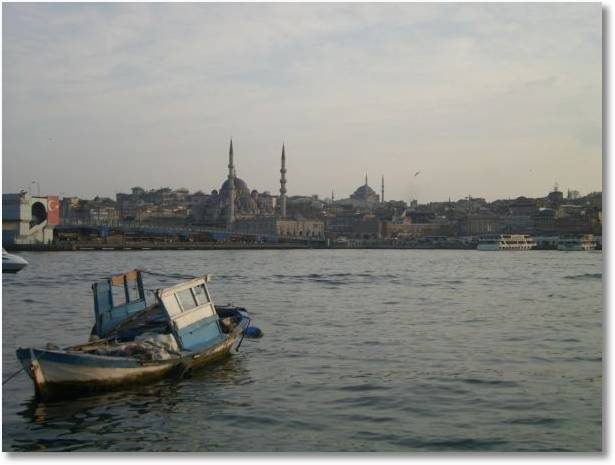All of my impressions of Milan are colored by one ineluctible fact: it's not Rome. And after my time in Rome, that's an unfair handicap for it to have to overcome. The day before arriving in Milan, I said goodbye to Rome – to the monuments, the churches, the neighborhood supermarket, the cobbled streets, the bum on the corner who made paper swans, but most of all my friends. It was a sad goodbye, and it seemed like I had been there more than five months.
 But this post is abot Milan, and I should write about Milan. First of all, it's nicer than I expected. In the list of Italian tourist destinations, Milan gets short shrift: it has the reputation of being the boring epitome of the industrialized north, good for fashion but nothing else. Well, true enough, it is smelly and polluted and noisy, and you have to take a shower after being outside in the smog for two hours. But it also has some real beauty to offer.
But this post is abot Milan, and I should write about Milan. First of all, it's nicer than I expected. In the list of Italian tourist destinations, Milan gets short shrift: it has the reputation of being the boring epitome of the industrialized north, good for fashion but nothing else. Well, true enough, it is smelly and polluted and noisy, and you have to take a shower after being outside in the smog for two hours. But it also has some real beauty to offer.
The Duomo is the obvious place to start. In addition to being massive, it is infinitely complex and detailed. From a distance, the overall form is evident and elegant in its symmetry. Closer up, the intricacy of the decorations comes into view, showcasing subtle designs within designs within self-similar designs. It reminds me of one of those fractal images . The detail doesn't degrade into clutter, which is an accomplishment. Everything is done with enough consistency of style and material to avoid seeming like an old lady's mantlepiece. Viewed from different angles, the architectural elements align in a multiplicity of fascinating arrangements, allowing for some great photo opportunities.
One of the things that strikes me most about these old cathedrals, especially one as complex as this, is that every piece had to be carved by hand. Every flower, every twirl, every bead or dash. It's not as if they could have gone to the Home Depot and said, "Um, let's see… I'll take one Crenellation Number Five[tm], those gothic window frames there, a pair of those gargoyles (you have them in travertine, right?)… oh yeah, and every saint statue you have."
The other obvious tourist attraction is Leonardo's Last Supper. I don't think I need to describe why this is worth seeing. If you want to see it, call ahead and book a time. Stupidly, I didn't do that, so I didn't get to see it.
Down the road, Castel Sforzesco is full of museums, including the Museo d'Arte Antica, where you'll find the Rondanini Pieta, Michelangelo's "other" pieta. He completed the one in Rome's St. Peter's Basilica at age 24. He started the one in Milan at age 80, but never finished because he was inconveniently interrupted by the Grim Reaper. Because of its unfinished nature, it gives insights into how the old master worked; for example, there is an unattached arm hanging off the back, having been replaced in the composition by another (unfinished) one. It appears ready to be knocked off with one blow when the new one is finished. (My father, C. Edmund Sullivan , can tell you much more about it. An exceptional artist himself, he knows more than a thing or two about Michelangelo.)
As far as tourist sights, that's all I really saw. I'm still inthe tranquillo Italian mentality of taking some time to drink a coffee or to walk a bit slower.
The milanesi, while still obviously Italian, have a different style than the Romans. They talk through their noses and wear expensive(r) clothes. The women have very long hair, short skirts, and very high heels.
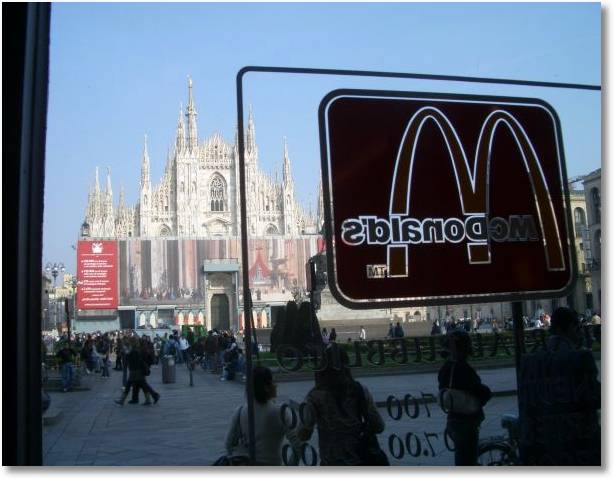 As far as food goes, for breakfast, lunch, and mid-afternoon snack, I had nothing but foccaccia bread, basically flattish crispy white bread with olive oil and salt on top. In Rome, if it were a bit thinner it would be called pizza bianca. (The Italian definition of pizza is broader than ours, or rather, as my brother Chris pointed out, ours has become more limited. Italians don't require either tomato sauce or cheese for something to be called pizza, though that is the most common form). For dinner, I went to an Irish pub, bought a pint of Guinness, and filled up on their apertivo, which is basically a free buffet. The English word for it is a French word, apertif , but it doesn't really exist around our parts. So as far as food goes, I can't comment much on Milan, but I did see a lot of McDonald's restaurants, which is not a good sign.
As far as food goes, for breakfast, lunch, and mid-afternoon snack, I had nothing but foccaccia bread, basically flattish crispy white bread with olive oil and salt on top. In Rome, if it were a bit thinner it would be called pizza bianca. (The Italian definition of pizza is broader than ours, or rather, as my brother Chris pointed out, ours has become more limited. Italians don't require either tomato sauce or cheese for something to be called pizza, though that is the most common form). For dinner, I went to an Irish pub, bought a pint of Guinness, and filled up on their apertivo, which is basically a free buffet. The English word for it is a French word, apertif , but it doesn't really exist around our parts. So as far as food goes, I can't comment much on Milan, but I did see a lot of McDonald's restaurants, which is not a good sign.
One word of warning: accomodation is pricey, and there are no real budget options. The one hostel in town, called Postello, is the dumpiest dump that ever was dumped, and a bit scarey. There are some cheapish hotels near the Stazione Centrale , but be careful in that neighborhood.
Milan's not Rome, but don't let that cross it off your list of Italian destinations. Milan's not Rome, but it still has something in store for the visitor: it's Milan.

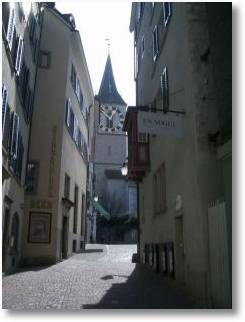 Zurich is pretty enough, but it's really, really, ridiculously expensive. It's fairly pretty, but it's too cold, with a mean mid-March wind moving along the lake. I guess it's pretty, but – Did I mention it's expensive? Not only that, but things cost a lot, too. Don't go there.
Zurich is pretty enough, but it's really, really, ridiculously expensive. It's fairly pretty, but it's too cold, with a mean mid-March wind moving along the lake. I guess it's pretty, but – Did I mention it's expensive? Not only that, but things cost a lot, too. Don't go there.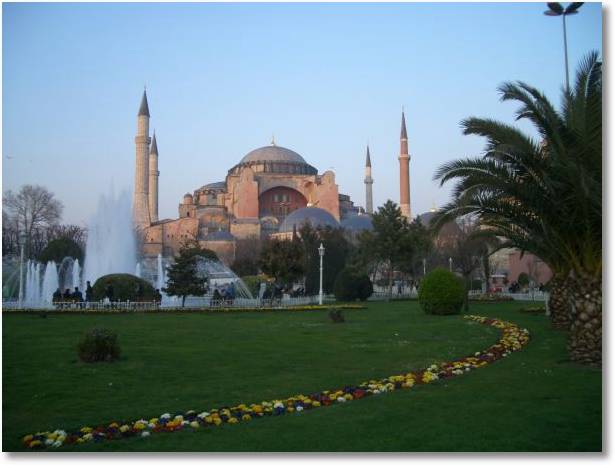 Istanbul is surprising. Every western visitor I met in Istanbul was amazed at what the city has to offer – the architecture, the natural beauty, the food, and – the most surprising part, at least for me – all the conveniences of a modern city. If you know your history, you know Istanbul was the capital of three major empires – Holy Roman, Byzantine, Ottoman; and it shows. It experienced the same building-on-top-of-building that Rome did. The Aya Sofia, for example, is a museum that used to be a mosque that used to be a church, and who knows what was there before that. (The name means “Saint Sofia.”) The point is, it’s really old and really beautiful and really big. That’s pretty much what I look for in a building.
Istanbul is surprising. Every western visitor I met in Istanbul was amazed at what the city has to offer – the architecture, the natural beauty, the food, and – the most surprising part, at least for me – all the conveniences of a modern city. If you know your history, you know Istanbul was the capital of three major empires – Holy Roman, Byzantine, Ottoman; and it shows. It experienced the same building-on-top-of-building that Rome did. The Aya Sofia, for example, is a museum that used to be a mosque that used to be a church, and who knows what was there before that. (The name means “Saint Sofia.”) The point is, it’s really old and really beautiful and really big. That’s pretty much what I look for in a building.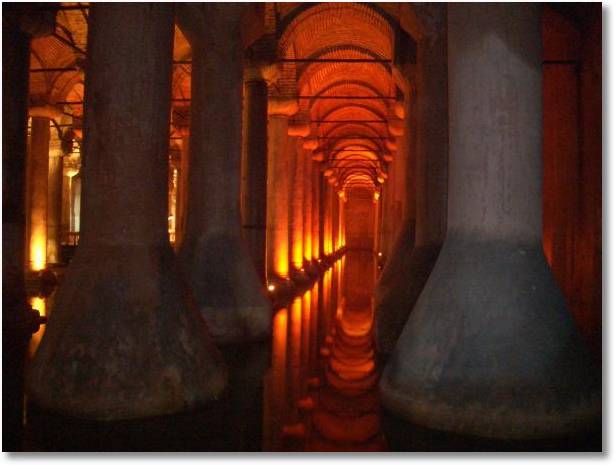 The Basilica Cistern is another thing of beauty, left over from the Roman age. I never did quite figure out what it’s for, but it’s a massive underground chamber lined with a rows and rows of columns, all submerged in about three feet of water. It is eerie in it’s dim lighting.
The Basilica Cistern is another thing of beauty, left over from the Roman age. I never did quite figure out what it’s for, but it’s a massive underground chamber lined with a rows and rows of columns, all submerged in about three feet of water. It is eerie in it’s dim lighting.